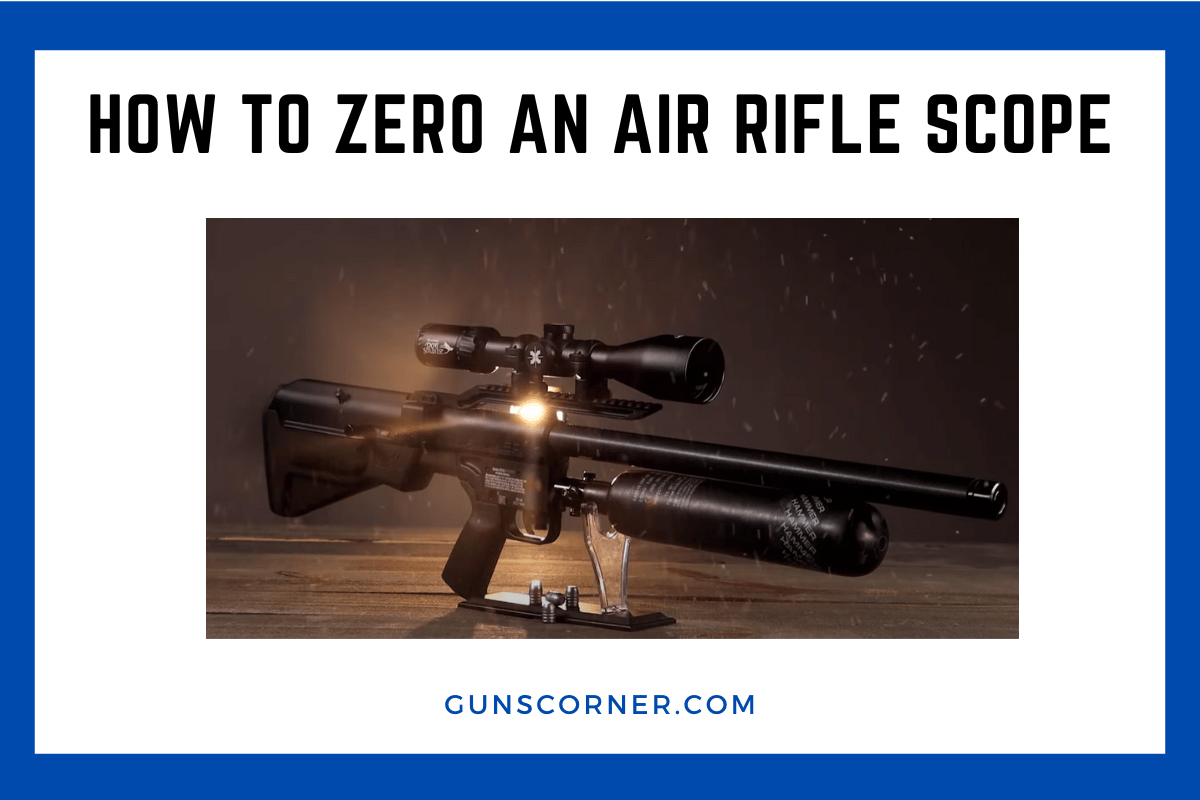Zeroing an air rifle scope is a crucial skill for any airgun enthusiast. It ensures accuracy and precision when shooting targets or hunting small game.
To zero an air rifle scope, shooters typically sight in at distances between 20 to 40 yards, depending on their intended use.
Getting your scope properly zeroed can seem tricky at first, but with the right approach, it’s a straightforward process. Zeroing involves adjusting the scope so that the point of aim matches the point of impact at a specific distance. This article will guide you through the steps to achieve a perfect zero on your air rifle scope.
Whether you’re a beginner or an experienced shooter looking to refresh your skills, mastering the art of zeroing your scope will greatly improve your shooting experience.
From selecting the right distance to making precise adjustments, we’ll cover everything you need to know to get your air rifle shooting accurately.
Key Takeaways
- Zeroing distance varies based on intended use, typically 20-40 yards
- Proper shooting position and consistent aim are essential for accurate zeroing
- Regular maintenance and re-zeroing ensure continued accuracy over time
Understanding Scope Adjustment
Scope adjustment is key to accurate shooting with an air rifle. It involves aligning the scope with the rifle’s point of impact. Proper adjustment ensures your shots hit the target where you aim.
Types of Air Rifle Scopes
Air rifle scopes come in different varieties. Fixed magnification scopes offer a single zoom level. Variable magnification scopes allow adjustable zoom.
Some scopes are made specifically for air rifles. These are built to handle the unique recoil of air guns. They often have parallax adjustment set for closer ranges.
Mil-dot reticles are common in air rifle scopes. They help shooters estimate distance and compensate for bullet drop.
Key Components for Sighting
The main parts for sighting an air rifle scope are turrets and reticles. Turrets are knobs on top and side of the scope. They adjust the scope’s aim.
The elevation turret moves the point of impact up or down. The windage turret moves it left or right.
Reticles are the crosshairs you see when looking through the scope. They help you aim at your target.
Some scopes have illuminated reticles. These are helpful in low light conditions.
Terminology: MOA and Windage/Elevation
MOA stands for Minute of Angle. It’s a unit of measurement for scope adjustments.
1 MOA equals about 1 inch at 100 yards. Many scopes adjust in 1/4 MOA increments.
Windage refers to horizontal adjustments. It helps compensate for wind or align the scope left or right.
Elevation refers to vertical adjustments. It helps compensate for bullet drop or align the scope up or down.
Understanding these terms helps shooters make precise adjustments to their scopes.
Preparation for Zeroing
Getting ready to zero your air rifle scope takes some important steps. These steps help make sure your scope is set up right and ready for accurate shooting.
Choosing the Right Mounting Equipment
Pick mounts that fit your rifle and scope. Secure mounts are key for a steady aim. Look for high-quality rings that match your scope’s diameter.
Different rifles need different types of mounts. Some use dovetail rails, while others have Picatinny or Weaver rails. Make sure to get mounts that work with your rifle’s rail system.
Consider the height of the mounts too. You want your eye to line up well with the scope when you’re in a comfortable shooting position.
Secure and Align Scope Mounts
Put the mounts on the rifle’s rail. Use a level to make sure they’re straight.
Tighten the screws, but don’t overdo it. Too tight can damage the rail or mount.
Place the scope in the rings. Don’t tighten them all the way yet.
Adjust the scope so it sits level in the mounts. Use a bubble level on top of the scope to check.
Make sure there’s enough eye relief. This is the distance between your eye and the scope’s eyepiece. It should be about 3-4 inches for most air rifles.
Once everything looks good, tighten the ring screws in a crisscross pattern. This helps keep even pressure on the scope.
Initial Boresighting
Boresighting helps get the scope close to zero before shooting.
For break-barrel air rifles, look down the barrel at a target about 10 yards away.
Without moving the rifle, adjust the scope’s crosshairs to match where the barrel is pointing. This gives a rough alignment to start with.
For fixed-barrel air rifles, use a laser boresighter. Put it in the muzzle and turn it on.
Adjust the scope to line up with the laser dot on your target.
Remember, boresighting is just a starting point. You’ll still need to fine-tune at the range.
The Zeroing Process
Zeroing an air rifle scope involves precise adjustments to align the point of aim with the point of impact. This process requires careful setup, proper technique, and methodical fine-tuning.
Setting Up the Target
Place a target at your chosen zeroing distance. Most shooters zero at 10 to 30 yards. Use a sturdy target stand to keep the paper still.
Choose a target with a clear bullseye and grid lines. This helps track shot placement easily.
Set up a safe backstop behind the target to catch pellets. A thick foam board or pellet trap works well.
Make sure the shooting area is well-lit. Good visibility is key for accurate aiming and shot placement.
Positioning and Posture for Accuracy
Find a stable shooting position. A bench rest or bipod provides the most stability.
Keep your body relaxed but firm. Tense muscles can cause unwanted movement.
Use a consistent cheek weld on the stock for each shot. This helps maintain the same sight picture.
Control your breathing. Take slow, deep breaths and pause between inhale and exhale to shoot.
Squeeze the trigger smoothly. Avoid jerking or pulling, which can throw off your aim.
Adjusting for Elevation
Start by firing a group of 3-5 shots at the target center. Note where the pellets hit.
If shots land below the aim point, adjust the elevation turret up. Turn it clockwise.
If shots are high, turn the elevation turret down (counterclockwise).
Most scopes adjust in 1/4 MOA increments. One click usually moves the point of impact 1/4 inch at 100 yards.
Make small adjustments. Shoot another group after each change to check the results.
Adjusting for Windage
Once elevation is set, focus on left-right accuracy. Fire another group of shots.
If pellets hit left of center, adjust the windage turret right (clockwise).
For impacts right of center, turn the windage turret left (counterclockwise).
Like elevation, make small adjustments. Many scopes use 1/4 MOA clicks for windage too.
Keep shooting groups and adjusting until shots consistently hit the bullseye.
Testing and Refining
After initial zeroing, test at different distances. This helps understand your rifle’s trajectory.
Fire groups at closer and farther ranges than your zero distance. Note the point of impact shifts.
Fine-tune your zero if needed based on your most common shooting distance.
Check your zero periodically, especially after transporting the rifle. Scopes can shift over time.
Practice regularly to maintain your shooting skills and familiarity with your zeroed rifle.
Maintaining Zero
Keeping your air rifle scope zeroed is crucial for accuracy. Regular checks and proper care help maintain your zero over time.
Checking Zero Regularly
Checking your zero before each shooting session is important. Shoot a few pellets at your zeroing distance to confirm accuracy. If you notice a shift, make small adjustments to bring the point of impact back to center.
Keep a log of your zero settings. This helps track changes over time and makes it easier to reset if needed.
Use a consistent shooting position when checking zero. This reduces variables that could affect your results.
Environmental Factors Affecting Zero
Temperature changes can impact your scope’s zero. Extreme heat or cold may cause slight shifts in point of impact.
Humidity can affect pellet trajectory. High humidity may cause pellets to drop slightly lower than normal.
Wind is a major factor in air rifle shooting. Learn to read wind conditions and adjust your aim accordingly. Practice shooting in various conditions to understand how your rifle performs.
Storing and Transporting Your Riflescope
Protect your scope when not in use. Use lens covers to prevent dust and scratches.
Store your rifle in a cool, dry place. Avoid extreme temperatures that could affect the scope’s internal components.
When transporting your rifle, use a padded case. This protects the scope from bumps and jolts that could knock it out of zero.
Before shooting after transport, do a quick zero check. Small impacts during travel can affect accuracy.
Handle your rifle with care. Avoid bumping or dropping it, as this can easily throw off your zero.

